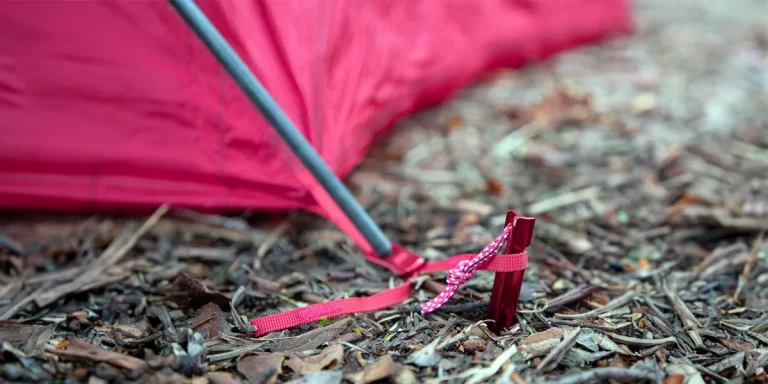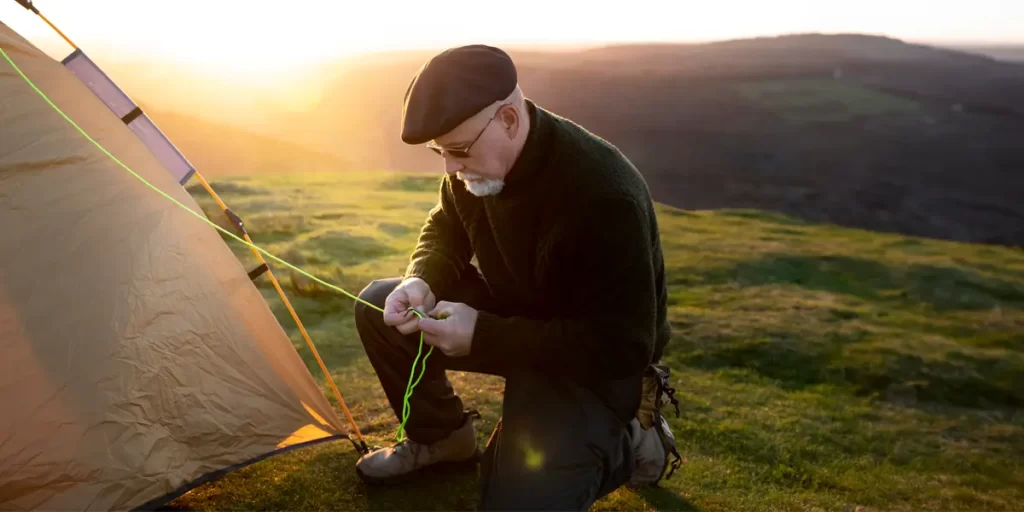

Have you ever wondered how to choose tent stakes with the seemingly endless options available? You want to make sure that you select the best option for your needs. If so, you are in the right place.
In this post, we’ll delve into the world of tent stakes. We’ll provide insights into various types of tent stakes, and guide you in selecting the ideal ones for you.
Interested? Let’s go.
Let’s take a closer look at the 4 common types of tent stakes you might encounter:
1. Y-Stakes

The Y-stake gets its name from its Y-shaped top view. These stakes are known for their resistance to bending, durability, and stability. Typically made of high-grade aluminum or titanium, Y-stakes provide excellent holding power and are less likely to spin in the ground.
Popular ultralight Y-stake options include:
| Make / Model | Weight oz (g) / stake |
|---|---|
| Sea to Summit Ground Control Light Tent Pegs | (7) |
| Zpacks Sonic Stakes | 0.32 (9) |
| MSR Mini Groundhog Stakes | (9.4) |
2. V-Stakes

V-stakes resemble a V-shape from the top view. They resist bending and are suitable for stability in most terrains. They offer excellent holding power. Usually constructed from materials like titanium.
Popular ultralight V-stake options include:
| Make / Model | Weight oz (g) / stake |
|---|---|
| Vargo Titanium Ascent Tent Stakes | 0.3 (8.5) |
| Hilleberg V-Pegs | 0.4 (11) |
| TOAKS Titanium V-Shaped Pegs | 0.4 (11) |
3. Shepherd’s Hook Stakes

Shepherd’s hook (also known as crook) stakes are lightweight but can be prone to bending and spinning in the ground. Wider versions are more stable but also heavier. These stakes are ideal for reducing pack weight, but you may need to replace them more frequently, especially if you camp in windy conditions.
Popular ultralight Shepherd’s hook Stake options include:
| Make / Model | Weight oz (g) / stake |
|---|---|
| Zpacks Ultralight Titanium Tent Stakes | 0.19 (5.4) |
| Vargo Titanium Ultralight Tent Peg | 0.2 (6) |
| MLD Easton Nano Nail Stakes | 0.4 (11) |
4. Nail Type Stakes

Nail-type tent stakes, or pins, are lightweight and great for hard ground. But be careful because they can spin and bend. Some may not have a strong hook, so they might lose the rope in windy weather. Still, they are one of the easiest to carry around.
Popular ultralight nail type stake options include:
| Make / Model | Weight oz (g) / stake |
|---|---|
| Vargo Titanium Ultralight Nail Pegs | 0.3 (8.5) |
| Nemo Airpin Ultralight Stakes | 0.4 (11) |
| MSR Core Stakes | 0.5 (14) |
Here’s a quick comparison table of the different types:
| Type | Pros | Cons | Weight |
|---|---|---|---|
| Y-stakes | Lightweight; Sturdy and stable in most conditions | Not great in sandy or loose soil; Can be difficult to insert into hard ground | Light |
| V-stakes | Easy to insert into hard ground; Grip well in loose or sandy soil | Heavier than Y-stakes; Not as stable in windy conditions | Medium |
| Shepherd’s hook stakes | Excellent holding power in soft ground (soil, grass) | Prone to bending | Light |
| Nail stakes | Lightweight; Very packable; Good for hard ground | Not very durable; Don’t grip well in loose soil | Light |
You can also find some design variations of the types of stakes listed here; however, the fundamental principles remain the same.
Additionally, there are specialized tent stakes available, such as snow stakes and ground screw stakes. Keep in mind that these are specialist gear, and you will know if you need something of that caliber.

Selecting the right tent stakes isn’t one-size-fits-all. Here are five key considerations:
When you’ve decided on the type of stake you prefer, the next step is picking from different backpacking tent stake materials.
Try to avoid stainless steel because of its weight and plastic because of its durability. When making your choice, consider these factors:
Here’s a comparison table for a quick understanding of the different materials:
| Material | Weight | Strength | Corrosion Resistance | Cost |
|---|---|---|---|---|
| Titanium | Very low | High | Excellent | High |
| Aluminum | Low | Medium | Good | Low |
| Carbon Fiber | Very low | Very high | Excellent | Very high |
In summary, the quality often aligns with the investment you make.
In this exploration of tent stakes, we’ve unveiled their vital role in camping, suitable for both seasoned adventurers and beginners. Remember that there’s no one-size-fits-all solution, so tailor your selection to your planned adventures and preferences.
We’ve covered various stake types, explained their features, and provided guidance for your selection.
Whether you choose to purchase durable Y-stakes or lightweight Shepherd’s hooks, your camping experiences now have a reliable foundation. Happy camping!
Looking for the lightest tent stakes on the planet? Check out our TOP 5 Guide on ultralight tent stakes.
When camping on sandy terrain, specialized tent stakes like sand/snow pegs are the top choice, thanks to their long and flat design that secures your tent in loose sand. However, Y-stakes can also be effective, especially when used with techniques like the deadman anchor. This combination enhances stability and ensures your tent remains secure on sandy beaches or dunes.
When considering tent stakes, you might wonder whether metal stakes outperform their plastic counterparts. In most camping scenarios, metal stakes, such as aluminum or titanium, tend to offer superior durability and reliability compared to plastic stakes. Metal stakes are less likely to bend or break, providing better stability for your tent, especially in challenging conditions. However, plastic stakes can still serve well for car camping or in less demanding situations.
When selecting tent stakes, consider the terrain where you’ll camp most – rocky areas call for nail stakes while sand requires wide shepherd’s hooks. Backpackers should opt for lightweight titanium or aluminum while car campers can choose heavier, durable steel. Stake length depends on soil type, with longer ones for loose ground. Aim for durable materials like titanium alloy or carbon fiber if you’ll reuse stakes often. Choose enough stakes for all tie-outs on your tent, and carry extras. The best stakes match your typical camping environment, balance durability and weight, and provide stability in expected conditions.
You don’t always need a hammer to put up a tent. Good tent pegs can go into the ground easily with just your hands or a little foot or knee pressure. These pegs, made of materials like aluminum or titanium, have sharp ends that can pierce the ground without needing a hammer. If you find it hard, you can use a lightweight tool called a stake pusher to make it easier. In really tough ground, like dry or rocky areas, a rubber mallet can help, but be careful not to damage the pegs. With some practice and the right techniques, you can set up your tent without needing a hammer most of the time.